| Look up intermodal in Wiktionary, the free dictionary. |
Intermodal transport (or intermodal transportation) involves the use of more than one mode of transport for a journey. It may refer to:
| Look up intermodal in Wiktionary, the free dictionary. |
Intermodal transport (or intermodal transportation) involves the use of more than one mode of transport for a journey. It may refer to:
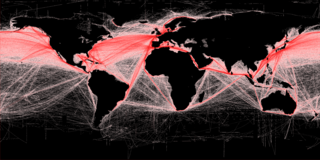
Freight transport is the physical process of transporting commodities and merchandise goods and cargo. The term shipping originally referred to transport by sea but in American English, it has been extended to refer to transport by land or air as well. "Logistics", a term borrowed from the military environment, is also used in the same sense.

An intermodal container, often called a shipping container, is a large standardized shipping container, designed and built for intermodal freight transport, meaning these containers can be used across different modes of transport – from ship to rail to truck – without unloading and reloading their cargo. Intermodal containers are primarily used to store and transport materials and products efficiently and securely in the global containerized intermodal freight transport system, but smaller numbers are in regional use as well. These containers are known under a number of names, such as simply container, cargo or freight container, ISO container, shipping, sea or ocean container, sea van or (Conex) box, container van, sea can or c can.

Intermodal freight transport involves the transportation of freight in an intermodal container or vehicle, using multiple modes of transportation, without any handling of the freight itself when changing modes. The method reduces cargo handling, and so improves security, reduces damage and loss, and allows freight to be transported faster. Reduced costs over road trucking is the key benefit for inter-continental use. This may be offset by reduced timings for road transport over shorter distances.

Lithuanian Railways, abbreviated LTG, is the national state-owned railway company of Lithuania. It operates most of the railway network in the country.

Intermodal passenger transport, also called mixed-mode commuting, involves using two or more modes of transportation in a journey. Mixed-mode commuting is often used to combine the strengths of various transportation options. A major goal of modern intermodal passenger transport is to reduce dependence on the automobile as the major mode of ground transportation and increase use of public transport. To assist the traveller various intermodal journey planners such as Rome2rio and Google Transit have been devised to help travellers to plan and schedule their journey.

Rail freight transport is the use of railroads and trains to transport cargo as opposed to human passengers.
A freight rate is a price at which a certain cargo is delivered from one point to another. The price depends on the form of the cargo, the mode of transport, the weight of the cargo, and the distance to the delivery destination. Many shipping services, especially air carriers, use dimensional weight for calculating the price, which takes into account both weight and volume of the cargo.
A dry port is an inland intermodal terminal directly connected by road or rail to a seaport, operating as a centre for the transshipment of sea cargo to inland destinations.

A refrigerated container or reefer is an intermodal container used in intermodal freight transport that is capable of refrigeration for the transportation of temperature-sensitive, perishable cargo such as fruits, vegetables, meat, and other similar items.
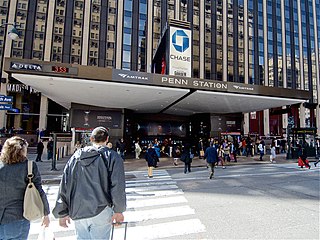
A transport hub is a place where passengers and cargo are exchanged between vehicles and/or between transport modes. Public transport hubs include train stations, rapid transit stations, bus stops, tram stops, airports and ferry slips. Freight hubs include classification yards, airports, seaports and truck terminals, or combinations of these. For private transport by car, the parking lot functions as a hub.
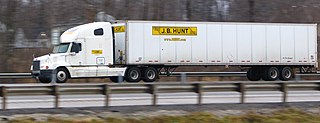
J.B. Hunt Transport Services, Inc. is an American transportation and logistics company based in Lowell, Arkansas. It was founded by Johnnie Bryan Hunt and Johnelle Hunt in Arkansas on August 10, 1961. By 1983, J.B. Hunt had grown into the 80th largest trucking firm in the U.S. and earned $623.47 million in revenue. At that time J.B. Hunt was operating 550 tractors, 1,049 trailers, and had roughly 1,050 employees. J.B. Hunt primarily operates large semi-trailer trucks and provides transportation services throughout the continental U.S., Canada and Mexico. The company currently employs over 24,000 and operates more than 12,000 trucks. The company's fleet consists of over 100,000 trailers and containers.

Transport geography or transportation geography is a branch of geography that investigates the movement and connections between people, goods and information on the Earth's surface.
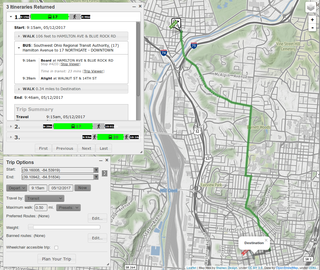
A journey planner, trip planner, or route planner is a specialized search engine used to find an optimal means of travelling between two or more given locations, sometimes using more than one transport mode. Searches may be optimized on different criteria, for example fastest, shortest, fewest changes, cheapest. They may be constrained, for example, to leave or arrive at a certain time, to avoid certain waypoints, etc. A single journey may use a sequence of several modes of transport, meaning the system may know about public transport services as well as transport networks for private transportation. Trip planning or journey planning is sometimes distinguished from route planning, which is typically thought of as using private modes of transportation such as cycling, driving, or walking, normally using a single mode at a time. Trip or journey planning, in contrast, would make use of at least one public transport mode which operates according to published schedules; given that public transport services only depart at specific times, an algorithm must therefore not only find a path to a destination, but seek to optimize it so as to minimize the waiting time incurred for each leg. In European Standards such as Transmodel, trip planning is used specifically to describe the planning of a route for a passenger, to avoid confusion with the completely separate process of planning the operational journeys to be made by public transport vehicles on which such trips are made.
Transloading is the process of transferring a shipment from one mode of transportation to another. It is most commonly employed when one mode cannot be used for the entire trip, such as when goods must be shipped internationally from one inland point to another. Such a trip might require transport by truck to an airport, then by airplane overseas, and then by another truck to its destination; or it might involve bulk material loaded to rail at the mine and then transferred to a ship at a port. Transloading is also required at railroad break-of-gauge points, since the equipment can not pass from one track to another unless bogies are exchanged.

Transport (BE) or transportation (AE) is the movement of humans, animals, and goods from one location to another. In other words, the action of transport is defined as a particular movement of an organism or thing from a point A to a point B.
Multimodal transport is the transportation of goods under a single contract, but performed with at least two different modes of transport; the carrier is liable for the entire carriage, even though it is performed by several different modes of transport. The carrier does not have to possess all the means of transport, and in practice usually does not; the carriage is often performed by sub-carriers. The carrier responsible for the entire carriage is referred to as a multimodal transport operator, or MTO.
A shipping container is a container with strength suitable to withstand shipment, storage, and handling. Shipping containers range from large reusable steel boxes used for intermodal shipments to the ubiquitous corrugated boxes. In the context of international shipping trade, "container" or "shipping container" is virtually synonymous with "intermodal freight container," a container designed to be moved from one mode of transport to another without unloading and reloading.
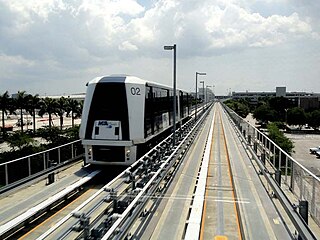
The MIA Mover is an automated people mover (APM) system which opened at the Miami International Airport (MIA) in metropolitan Miami, Florida, United States on September 9, 2011. The MIA Mover is designed to quickly transport landside passengers between Miami International Airport's Main Terminal and the Miami Intermodal Center (MIC). The MIA Mover is one of three separate automated people movers operating at the airport. The others are the Skytrain, which operates within Concourse D, and the MIA e Train people mover connecting Concourse E's satellite building.
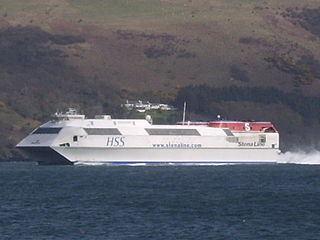
Accompanied combined transport is a form of intermodal transport, which is the movement of goods in one and the same loading unit or road vehicle, using successively two or more modes of transport without handling the goods themselves in changing modes. More specifically, accompanied combined transport is one of the two types of combined transport, which is intermodal transport where the major part of the journey is by rail, inland waterways or sea, and any initial and/or final legs carried out by road are as short as possible.
Combined transport is a form of intermodal transport, which is the movement of goods in one and the same loading unit or road vehicle, using successively two or more modes of transport without handling the goods themselves in changing modes. Combined transport is intermodal transport where the major part of the journey is by rail, inland waterways or sea, and any initial and/or final legs carried out by road are as short as possible.